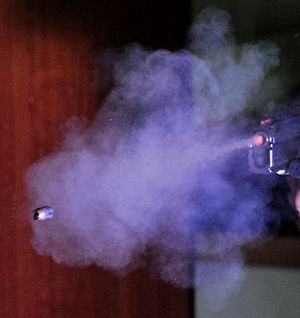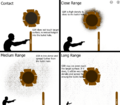Gunshot residue facts for kids
Gunshot residue (GSR) is tiny bits of material left behind when a gun is fired. When a bullet shoots out of a gun's barrel, it's pushed by hot gases. These gases carry tiny pieces of burned and unburned gunpowder.
GSR also contains tiny traces of metal from the gun itself, the ammunition, and a part called the primer. The main ingredients of GSR are lead, barium, and antimony. You can often find GSR on the skin and clothing of the person who fired the gun. It might also be found near where the bullet entered a target, depending on how close the gun was.
Contents
How Scientists Study Gunshot Residue
When a gun is fired, a cloud of gas and GSR particles shoots out from the barrel and other openings. These tiny particles land on anything nearby, including the gun itself.
Collecting GSR Evidence
Crime scene specialists collect GSR from people and objects if they think it might be there. They take these samples to a laboratory for testing. Forensic scientists can use GSR to figure out how far away the gun was from its target when it was fired. The farther away the gun was, the less GSR will be found.
Time is Important for GSR Collection
Collecting GSR samples needs to be done quickly. After about 4 to 8 hours, GSR can wear off a person's hands. However, it can stay on a dead body or other objects for much longer.
New Ways to Test GSR
Scientists have made many improvements in how they examine gunshot residue. One big improvement is using scanning electron microscopes. These powerful microscopes help them see very tiny particles.
Recently, new tests have been developed to find GSR even when the ammunition used was "green" or lead-free. In the past, lead had to be in the sample to confirm it was GSR. Now, a new test can find GSR from even a single tiny particle.
What Finding GSR Can Mean
Finding GSR doesn't always mean someone fired a weapon. It can also show:
- A person was standing very close to the gun when it was fired.
- A person may have touched or handled a gun or ammunition.
- A person may have touched a surface that already had GSR on it.
Why GSR Might Not Be Found
Sometimes, GSR might not be found for several reasons:
- The person did not fire the weapon.
- No GSR was found on the specific area that was tested.
- The GSR was washed or wiped away from hands or clothing.
- Samples were taken more than 4 hours after the shooting.
Images for kids
See also
 In Spanish: Residuos de disparo para niños
In Spanish: Residuos de disparo para niños



